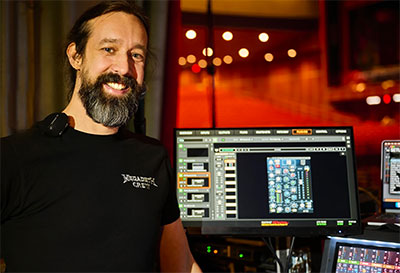Known for his work with Sepultura, Devin Townsend, Motörhead and Meshuggah, FOH Stanley Soares and producer/monitor engineer Chris Rakestraw jointly chose to mix Megadeth’s recent Cyber Army stadium tour using Waves plug-ins and the Waves SuperRack plug-in host, with DiGiCo Quantum 338 and Avid Venue S6L consoles.
 Soares’ current set-up includes Waves Mercury, the Studio Classics Collection and Abbey Road Collection bundles, and involves three dedicated computers – the first hosts Waves SuperRack, the second manages recording and virtual soundchecking via a DiGiGrid MGB interface, and the third handles Smaart audio/acoustic measurement and walk-in music playout.
Soares’ current set-up includes Waves Mercury, the Studio Classics Collection and Abbey Road Collection bundles, and involves three dedicated computers – the first hosts Waves SuperRack, the second manages recording and virtual soundchecking via a DiGiGrid MGB interface, and the third handles Smaart audio/acoustic measurement and walk-in music playout.
‘The Waves integration provides a clean and efficient workflow, allowing me to keep focus on the mix,’ Soares says. ‘Several plug-ins are my go-to’s. I consider the F6 Floating-Band Dynamic EQ as the The Swiss Army Knife of plug-ins; the F6 is a perfect fit for many of my applications, not to mention that it’s zero latency. I apply it on my snare bus, for instance, to expand 4-5kHz range at every hit, adding a bite to the snare tone without introducing excessive hi-hat bleed. I also use it on bass guitar to selectively subtract and expand certain frequencies. This approach makes it easier to keep the bass low end in check, by taming the areas with more energy in large resonant rooms, while expanding the high mids for a clearer tone. Another great use is to control the mic proximity effect on vocals, where I usually set one of the floating bands around 100-200Hz on the F6, allowing it to dynamically adapt to the vocal performance without compromising the tonality.
‘Another favourite is Trans-X, which works wonders for percussive instruments. It’s my go-to for achieving a punchy kick and snare drum in my mix. The SSL-E Channel and SSL G-Master Bus Compressor bring me back to my studio times when I used to work on a SSL console. These plug-ins really capture the feel and characteristics of the console. I have the SSL-E Channel strip across guitars, drums and vocals channels/busses, along with the SSL G-Master on the master fader to tie everything together [settings 2:1 ratio, 30 attack, 0.1 release, and about 2dB or 3dB of gain reduction].’
‘The emulations of classic consoles in the NLS Non-Linear Summer plug-in are exceptional,’ he continues. ‘I use it to introduce harmonic distortion to bass and guitars, making them sound a bit edgy. Typically, I place it at the beginning of the chain, followed by the F6 for frequency management and then a H-EQ Hybrid Equalizer, which usually sits at the end of the chain and serves as my tone-shaping tool. H-EQ offers a range of console emulations that add all sorts of flavours to the sound: I love using its UK Vintage and Modern style filters on guitars.’
‘In my opinion, the Abbey Road TG Mastering Chain is one of the most musical EQs in a plug-in. I have several presets on this one, and I’m currently using one of them on my master bus for mixing Megadeth. This preset is basically an increment of 1dB EQ Shelf from 512Hz and above and another 1dB boost at 10kHz. These settings create a subtle “tilt”, providing openness and clarity across the whole mix. I use the Abbey Road Reel ADT on vocals, acoustic guitars and for some special guitar clean tone effects, such as in the of the song ‘A Tout Le Monde’, and at the breakdown of the song ‘Trust’ to add some depth and width.’
Producer Rakestraw, who also doubles as touring monitor engineer, says: ‘The greatest benefit of using Waves with my Avid console is not having to set up an extra computer and another screen to run SoundGrid, since the S6L allows you to control all of that.’ His set-up includes an Avid S6L with a couple Waves Titan-R SoundGrid Servers, Waves SoundGrid Rack for Venue and Waves’ Mercury, Studio Classics Collection and Abbey Road Collection.
 Like Soares, Rakestraw favours the F6 dynamic EQ.
Like Soares, Rakestraw favours the F6 dynamic EQ.
‘F6 is number one on my plug-in list. With Megadeth, we have hypercardioid Beta 58s on stage for vocals. The low-end proximity effect on hypercardioids can be really sensitive to the distance from the mic, which ends up being quite unpredictable. With the F6, I can set a couple different bands to handle the amount of low end coming through. I keep a pretty aggressive band for plosives, then a band for lows around 150-200Hz, and a mud band around 300-500Hz. [singer] Dave Mustaine has what I would consider “many voices” in his vocal range, so this helps navigate all of his different tones. I can’t really see mixing any vocalist without this plug-in. I never keep the same setting, since I make slight adjustments every night, depending on what’s happening with Dave’s voice. Touring can be really hard on singers, as there are good nights and bad nights, and the F6 helps me navigate changes in vocal tone/quality.
‘I also use the CLA-2A Compressor/Limiter on Dave’s vocals.’ he adds, ‘I have to be pretty sparing with compression, otherwise the compressor just pulls in garbage ambience from the venue, but I just like the way this compressor sounds. I’d be surprised if I ever pass 2dB of reduction with this, but I notice when I remove it. And it is just two knobs, which means you can’t screw it up.
‘I use the PSE Primary Source Expander plug-in during every show on vocal mics, not to combat feedback, but rather to control venue ambience on the vocal mics. Most of the band’s mixes have the vocals louder than everything else, which means there’s a ton of super loud trash ambience coming through unless the PSE is in place. So on any given show, I’m using the PSE on a static setting for [bassist] James LoMenzo and [guitarist] Teemu Mantysaari’s backing vocals.
On Dave Mustaine, I’m usually manually riding the PSE to keep his ambience policed without stepping on his vocal. Basically, once Dave’s head is in front of the mic, I can turn the PSE off and just let him sing, without a gate interfering with his dynamics. Then with the slow release time on the PSE, I can engage the PSE at the last phrase or note, and the ‘gate action’ closes in real time to minimise hearing the ‘door slam shut,’ which can be distracting. The great thing about this, is that if I am troubleshooting or putting out a fire somewhere else, he can still sing through the threshold until I can get my hands back on the console.’
‘I love the Waves SSL EV2 Channel plug-in,’ he adds. ‘I think it’s the best-sounding SSL channel strip that I’ve used, by any brand, live or in the studio. I use the EV2 to sweeten up the guitars. I don’t think I’ve ever heard a guitar coming off of stage that didn’t benefit from this plug-in. I’m not too aggressive with the EQ, but to compete with all the other chaos on stage.’
Additional Rakestraw favourites include the Abbey Road Chambers, which he uses on acoustic guitars.
‘Acoustic guitar can sound terrible in the in-ear monitors, especially when it’s just a DI. If you don’t put some ambience around it, you might as well not even plug it in. As far as the setting, just pick something that doesn’t sound out of place and doesn’t crowd the ambience that’s already present at the venue. In other words, don’t put stadium-size reverb on an acoustic if you’re already in a stadium, just use the least amount possible to place the guitar into the real world.
‘I’m kind of embarrassed to admit that I use the JJP Bass plug-in, because it feels like ripping off another engineer, but I love it on bass DI and the bass amp. I’ve never met Jack Joseph Puig, but I do appreciate his plug-in. It can help make a basic-sounding bass DI into a more useful shaped sound. The Attack slider does great things, and the Presence slider handles the high end in a very useful manner. The CLA-3A is my first in-line compressor for bass. This is normally the first plug-in in my chain for both bass DI, and amp. And again, two knobs... can’t screw it up.’
Rakestraw and Soares sum up: ‘No matter where we’re playing in the world, and no matter what console we’re on, we can rest easy knowing that Waves has us covered with the reliable tools we need to mix the show.’














